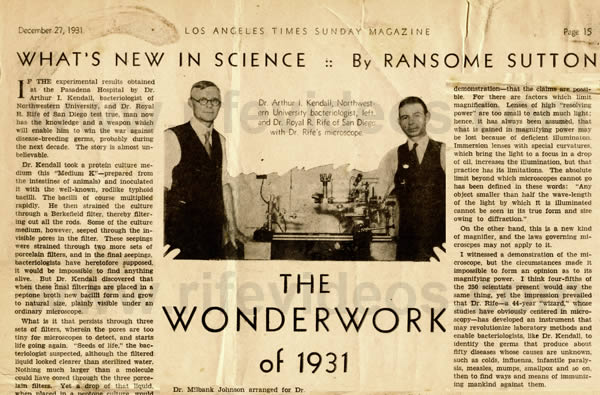|
The WONDERWORK of 1931
Los Angeles Times Sunday Magazine December 27, 1931
What's New In Science, By Ransom Sutton
If the experimental results obtained at the Pasadena Hospital by Dr. Arthur I. Kendall, bacteriologist of Northwestern University, and Dr. Royal R. Rife of San Diego test true, man now has the knowledge and the weapon which will enable him to win the war against disease breeding germs, probably during the next decade. The story is almost unbelievable. Dr. Kendall took a protein culture medium (his "Medium K" prepared from the intestines of animals) and inoculated it with the well-known, rodlike typhoid bacilli. The bacilli of course multiplied rapidly. He then strained the culture through a Berkefield filter, thereby filtering out all the rods. Some of the culture medium, however, seeped through the invisible pores in the filter. These seepings were strained through two more sets of porcelain filters, and in the final seepings, bacteriologist have heretofor supposed, it would be impossible to find anything alive. But Dr. Kendall discovered that when these final filterings are placed in a petone broth new bacilli form and grow to natural size, plainly visible under an ordinary microscope.
What is it that persist through the three sets of filters, wherein the spores are too tiny for microscopes to detect, and starts life going again. "Seeds of life," the bacteriologist suspected, although the filtered liquid looked clearer then sterilized water. Nothing much larger than a molecule could have oozed through the three porcelain filters. Yet a drop of that liquid, when placed in a peptone culture, would bring back the rods that produce typhoid. It was getting close to the source of creation. For Dr. Kendall was able to say: "let the waters bring forth abundantly the moving creature that hath life... whose seed is in itself," and the willing waters obeyed him.
Having heard about a "wonder microscope," [Rife microscope] said to have been invented by a young San Diegan, Dr. Kendall asked his friend, Dr. Milbank Johnson of Los Angeles, if such a microscope existed. Dr. Johnson did not know about it, but undertook to find out. Accompanied by doctors Alvin G. Foord, Joseph D. Heitger and Fosdick Jones, all of Pasadena, he drove to San Diego and found Royal Raymond Rife and a new kind of microscope, which he has been developing, as a hobby, during the past 17 years. Designed on a new plan entirely, this microscope has six quartz lenses, giving it a magnifying power eight times greater than the high powered-microscopes used by physicists.
Dr. Milbank Johnson arranged for Dr. Kendall and Dr. Rife to get together at the Pasadena Hospital where, we were told by both Dr. Kendall and Dr. Rife, the super microscope brought Kendall’s "seeds of life," distinctly within range of human vision. A bacillus or bacterium-a single cell organism-was seen to be made up of "granules," like the separate grains in a head of wheat, each granule being a free, motile, living thing. And it turned out that these granules are the "nearly nothings" that ooze through porcelain and reproduce the kind of an organism as the form from which they came. It also appeared that each kind of granule, whether from a typhoid bacillus or some other kind, has-under polarized light-a distinctive color of its own, thereby enabling bacteriologist to diagnose germ-diseases by the color of the germs. Bacilli may thus be studied by their light, exactly as astronomers study moons, suns and other stars by the light which comes from them through telescopes. The bacilli studied are living ones, not corpses killed by stained.
So extraordinary are these statements that scientists generally would regard them as visionary, or scientifically impossible, he if they were not vouched for by such distinguished authorities as Doctor of Medicine Johnson, and Dr. Kendall, experienced biologist. It is only fair to say that the physicist and the astronomers with whom I have discussed the matter are not yet convinced-after witnessing a demonstration-that the claims are possible. For there are factors which limit magnification. Lenses of high "resolving power" are too small to catch much light; hence, it has always been assumed that what is gained in magnifying power may be lost because of deficient illumination. Immersion lenses with special curvatures, which bring the light to a focus in a drop of oil, increases the illumination, but that practice has its limitations. The absolute limit beyond which microscopes cannot go has been defined in these words: "any object smaller than half of the wavelength of the light by which it is illuminated cannot be seen in its true form and size owing to diffraction."
On the other hand, this is a new kind of magnifier, and the laws governing microscopes may not apply to it. I witnessed a demonstration of the microscope, but the circumstances made it impossible to form an opinion as to its magnifying power. I think four-fifths of the 250 scientists present would say the same thing, yet the impression prevailed that Dr. Rife a 44 year "wizard," whose studies have obviously centered in microscopy-has developed an instrument that may revolutionize laboratory methods and enable bacteriologist, like Dr. Kendall, to identify the germs that produce about 50 diseases whose cause are unknown, such as colds, influenza, infantile paralysis, measles, mumps, smallpox and so on, then to find ways and means of immunizing mankind against them. |

